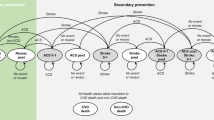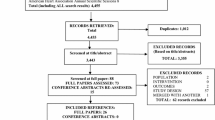Abstract
Background
The concept of cost effectiveness emerged in an attempt to link the prices of new healthcare technologies to the immediate value they provide, with payers defining the acceptable cost per unit of incremental effect over the alternatives available. It has been suggested that such measures allow developers to assess potential market profitability in an early stage of development, but may result in discouraging investment in efficient research if not used appropriately.
Objective
The objective of this study is to identify the pattern of the factors determining cost effectiveness and assess the evolution of cost-effectiveness potential for drugs in development using lipid-lowering therapy as a case study.
Methods
The study is based on observational clinical and market data covering a 20-year period (from 1990 to 2010) in the UK. Real-life clinical data including total cholesterol laboratory test results were extracted from the Clinical Practice Research Datalink (CPRD) and are used to illustrate how the clinical effectiveness of existing standard care changed over time in patients managed in clinical practice. Prescription Cost Analysis (PCA) data were extracted and the average price of the drug mix used was computed throughout the study period. Using this information, the maximum clinical benefit and cost savings to be had were estimated for each year of the analysis using a cost-effectiveness model. Subsequently, the highest price a new technology providing the maximum clinical effectiveness possible (i.e. eliminating cardiovascular risk from high cholesterol levels) could achieve under current cost-effectiveness rules was calculated and used as a measure of the potential cost effectiveness of drugs in development.
Results
The results in this study show that the total cholesterol values of patients managed in clinical practice moved steadily towards recommended clinical targets. Overall, the absolute potential for incremental health-related quality of life decreased by approximately 78 %, contracting from 0.36 QALYs to 0.08 QALYs, which resulted in a saving of approximately 15 % of the costs related to cardiovascular events. The price of the drug mix used in the management of high blood cholesterol varied considerably across the years: the weighted average monthly price (in year 2007 values) started at approximately £14, peaked around £26 and progressively decreased to its minimum at £6.85 in 2010. As a consequence, the maximum price allowed by current cost-effectiveness rules for a new technology achieving the clinical target was found to decrease by a minimum of 80 % between 1990 and 2010.
Conclusion
The analysis supports the hypothesis that the potential for cost effectiveness of new therapies is dependent on factors specific to each disease area and furthermore to sub-populations within disease areas. Despite a clinical need still existing, the results suggest that no more technologies are likely to be developed in certain disease areas based on their low perceived cost-effectiveness potential. This occurs without considering the immediate and future value of the effectiveness lost, which may depend on the technical difficulty of materializing future advancements, and ignores the permanent character of such a decision. The analysis suggests that a single, static and arbitrary cost-effectiveness threshold may not be sufficient to capture the drug-development dynamics occurring at the disease level and successfully direct research to the disease areas that are most valued by society.


Similar content being viewed by others
Notes
In this process, we followed the framework proposed by Refoios Camejo and colleagues [19] and assumed there was a physiologically defined clinical effectiveness ceiling (\( E_{D} \hbox{Max} \)) representing the maximum absolute clinical effectiveness that could be attained, i.e. when cure or maximum risk reduction was obtained. The maximum incremental clinical effectiveness a new technology could achieve (\( IE_{d} \hbox{Max} \)) was then computed by \(IE_{d} {\text{Max}} = E_{D} {\text{Max}} - E_{c} \), where \( E_{c} \) is the clinical effectiveness of available standard care.
The cost effectiveness of a new drug can be represented by the ratio of the incremental differences (of costs and benefits) between the new drug and existing comparators. A drug will be considered cost effective if the cost-effectiveness ratio is lower than the cost-effectiveness threshold in place. The maximum price (\( P_{D} \hbox{Max} \)) achievable for reaching \( E_{D} \hbox{Max} \) can then be computed taking in consideration the price of the comparator (\( P_{c} \)). When computed over time, \( P_{D} \hbox{Max} \) allows assessing the evolution of the potential for cost effectiveness and can roughly be used as an indicator of the prospects for clinical development in a particular disease area.
References
Attridge J. Innovation models in the biopharmaceuticals sector: innovation in Life Sciences Initiative. London: Imperial College London; 2006.
Abbott T, Vernon J. The cost of pharmaceutical price reductions: a financial simulation model of R&D decisions [NBER Working Series no. 11114]. Cambridge: NBER; 2005.
Bardey D, Bommier A, Jullien B. Retail price regulation and innovation: reference pricing in the pharmaceutical industry. J Health Econ. 2010;29(2):303–16.
Barton J, Emanuel E. The patents-based pharmaceutical development process: rationale, problems, and potential reforms. JAMA. 2005;294(16):2075–83.
Boersma C, Broere A, Postma M. Quantification of the potential impact of cost-effectiveness thresholds on Dutch drug expenditures using retrospective analysis. Value Health. 2010;13(6):853–6.
CBO. Research and development in the pharmaceutical industry. Washington: The Congress of the United States—Congressional Budget Office 2006.
Claxton K. OFT, VBP: QED? Health Econ. 2007;16:545–58.
Claxton K, Briggs A, Buxton M, Culyer A, McCabe C, Sculpher M, et al. Value-based pricing for NHS drugs: an opportunity not to be missed? British Med J. 2007;336:251–4.
Giacotto C, Santerre R, Vernon J. Drug prices and research and development investment behavior in the pharmaceutical industry. J Law Econ. 2005;48:195–214.
Hoyle M. Future drug prices and cost-effectiveness analyses. Pharmacoeconomics. 2008;26(7):589–602.
Hoyle M. Accounting for the drug life cycle and future drug prices in cost-effectiveness analysis. Pharmacoeconomics. 2011;29(1):1–15.
Jena A, Philipson T. Cost-effectiveness as a price control. Health Aff. 2007;26(3):696–703.
Jena A, Philipson T. Cost effectiveness analysis and innovation. J Health Econ. 2008;27(5):1224–36.
Kanavos P, Manning J, Taylor D, Schurer W, Checchi K. Implementing value-based price for pharmaceuticals in the UK. London: 2020health.org; 2010.
Kettle T, Moen J, Griliches Z. Do subsidies to commercial R&D reduce market failures? Microeconometric evaluation studies. Res Policy. 2000;29:471–95.
Lichtenberg F. Probing the link between gross profitability and R&D spending. Health Aff. 2001;20:221–2.
Mossialos E, Morel C, Edwards S, Berenson J, Gemmill-Toyama M, Brogan D. Policies and incentives for promoting innovation in antibiotic research. Geneva: WHO; 2010.
Pekarsky B. Should financial incentives be used to differentially reward ‘me-too’ and innovative drugs? Pharmacoeconomics. 2010;28(1):1–17.
Refoios Camejo R, McGrath C, Herings R. A dynamic perspective on pharmaceutical competition, drug development and cost effectiveness. Health Policy. 2011;100(1):18–24.
Refoios Camejo R, McGrath C, Herings R, Meerding W-J, Rutten F. Antihypertensive drugs: a perspective on pharmaceutical price erosion and its impact on cost-effectiveness. Value Health. 2012;15(2):381–8.
Refoios Camejo R, McGrath C, Rutten F. An empirical model of drug pricing and competition: a retrospective outlook of the pricing of lipid-lowering drugs. Int J Econ Bus Res. 2013;6 (in press).
Refoios Camejo R, McGrath C, Herings R, Starkie H, Rutten F. Assessing the determinants of the potential for cost effectiveness over time: the empirical case of COPD. Value Health. 2013;16(2):426–33.
Scherer F. The link between gross profitability and pharmaceutical R&D spending. Health Aff. 2001;20:216–20.
Sloan F, Hsieh C-R. The effects of incentives on pharmaceutical innovation. In: Sloan F, Kasper H, editors. Incentives and choice in health care. Cambridge: MIT Press; 2008.
Vernon J. Examining the link between price regulation and pharmaceutical R&D investment. Health Econ. 2004;14(1):1–16.
Vernon J, Hughen W, Johnson S. Mathematical modeling and pharmaceutical pricing: analyses used to inform in-licensing and developmental go/no-go decisions. Health Care Manag Sci. 2005;8:167–79.
The Health and Social Care Information Centre. PCA prescription cost analysis data 1980-2010. London: Department of Health; 2011. http://www.ic.nhs.uk/statistics-and-data-collections/primary-care/prescriptions. Accessed 4 Mar 2013.
Joint Formulary Committee. British National Formulary 61. London: British Medical Association and Royal Pharmaceutical Society; 2011.
European Society of Cardiology. European guidelines on cardiovascular disease prevention in clinical practice: full text. Eur J Cardiovasc Prev Rehabil. 2007;14(2):S1–113.
Conroy R, Pyorala K, Fitzgerald A, Sans S, Menotti A, De Backer G. Estimation of ten-year risk of fatal cardiovascular disease in Europe: the SCORE project. Eur Heart J. 2003;24:987–1003.
National Institute for Health and Clinical Excellence. NICE menu of Indicators. NICE: London; 2011 (updated 14 Sep 2012). http://www.nice.org.uk/aboutnice/qof/indicators.jsp. Accessed 13 Oct 2012.
Office for National Statistics. All items retail price index (RPI) percentage change over 12 months: Table RP04. Newport: Office for National Statistics; 2010.
National Institute for Health and Clinical Excellence. Guide to the methods of technology appraisal. London: NICE; 2008.
D’Agostino R, Russel M, Huse D, Ellison R, Silbershatz H, Wilson P, et al. Primary and subsequent coronary risk appraisal: new results from the Framingham study. Am Heart J. 2000;139:272–81.
Erhardt L, Gotto G Jr. The evolution of European guidelines: changing the management of cholesterol levels. Atherosclerosis. 2006;185(1):12–20.
National Institute for Health and Clinical Excellence. Statins for the prevention of cardiovascular events (technology appraisal 94). London: NICE; 2006.
National Collaborating Centre for Primary Care. Lipid modification—cardiovascular risk assessment and the modification of blood lipids for the primary and secondary prevention of cardiovascular disease [clinical guideline 67]. London: NICE; 2008.
European Pharmaceutical Market Research Association. EphMRA anatomical classification guidelines 2009. EphMRA: Basel; 2009.
The Medicines and Healthcare products Regulatory Agency. Clinical practice research datalink. London: MHRA. http://www.cprd.com/. Accessed 3 Mar 2013.
The Health and Social Care Information Centre. Hospital episode statistics for England: inpatient statistics. Leeds: The Health and Social Care Information Centre; 2011. http://www.hesonline.nhs.uk. Accessed 3 Mar 2013.
National Institute for Health and Clinical Excellence. Prevention of cardiovascular disease at the population level (PH25). London: NICE; 2010. http://www.nice.org.uk/ph25. Accessed 3 Mar 2013.
Acknowledgments
Whilst conducting this study, R. Refoios Camejo was supported by the Portuguese Fundação para a Ciência e a Tecnologia (FCT), and C. McGrath was an employee of Pfizer when this study was planned and the data were extracted and analysed. Clare McGrath is now an employee of AstraZeneca. However, ideas expressed in this paper are entirely those of the authors and do not necessarily represent the views of FCT, Pfizer or AstraZeneca. Access to CPRD data was funded by Pfizer, but the publication of the study was not contingent on Pfizer’s approval or any censorship of the manuscript. We thank the reviewers of the CPRD Independent Scientific Advisory Committee for their insightful comments on the study protocol.
Author Contributions
All authors contributed extensively to the work presented in this paper. R. Refoios Camejo designed the study, extracted the data, conducted the analyses and prepared the manuscript; C. McGrath participated in the design of the study and contributed to the writing of the manuscript; M. Miraldo scrutinized the whole analytical procedure, ensuring the quality and validity of the analysis, and participated in the writing of the manuscript; and F. Rutten participated in the design of the study, contributed to the writing of the manuscript, and ensured the overall quality of the study. R. Refoios Camejo acts as guarantor for the overall content.
Author information
Authors and Affiliations
Corresponding author
Electronic supplementary material
Below is the link to the electronic supplementary material.
Rights and permissions
About this article
Cite this article
Refoios Camejo, R., McGrath, C., Miraldo, M. et al. The Determinants of Cost-Effectiveness Potential: An Historical Perspective on Lipid-Lowering Therapies. PharmacoEconomics 31, 445–454 (2013). https://doi.org/10.1007/s40273-013-0041-x
Published:
Issue Date:
DOI: https://doi.org/10.1007/s40273-013-0041-x




